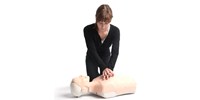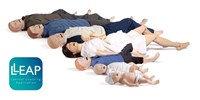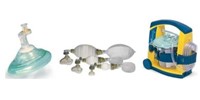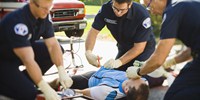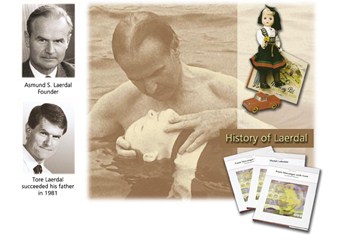Laerdal History
Our company started as a small publishing house in 1940, specialising in greetings cards and beautiful children's books. Having to rely on domestic raw materials in war time Norway, Asmund S. Laerdal soon expanded into the manufacturing of wooden toys.
Pioneering in soft plastics in the early 50's, Laerdal made millions of realistic play dolls and "furniture friendly" toy cars. Realistic wound simulations and the life-size, life-like Resusci Anne, a training manikin for mouth-to-mouth resuscitation, set a new course. The Girl from the River Seine. First aid and emergency medicine became our field of activity, with an emphasis on training.
In the 60's pre-hospital emergency medicine began to be seen as an extension of advanced hospital treatment. To increase the practical usefulness of these ideas Laerdal developed easily portable equipment for ventilation and airway control, and began a tradition of offering equipment along with complementary training aids.
In the 70's the Laerdal Foundation for Acute Medicine was founded. Over the years it has been able to support a considerable number of research, education and publication projects.
In the 80's early defibrillation was shown to decisively increase the survival rate of pre-hospital cardiac arrest. This triggered the development of our Heartstart semi-automatic defibrillator, enabling ambulance personnel without long medical training to provide this life saving treatment.
In the 90's our Stifneck collars provide new possibilities for preventing needless injury and disablement from cervical spine injuries.
Continually adding to this line, Laerdal remains the world's leading supplier of quality emergency medicine products for use outside as well as inside hospitals.
For our 50th anniversary the history of Laerdal in war and peace time, and through three different fields of business, appeared in a book called "From Stavanger with Care", written by a Stavanger journalist. More than anything it is the story of Asmund S. Laerdal whose creativity and dedication was honoured by being recognised as a practical industrial partner to leading medical research and care institutions. We are proud to continue this tradition.
Establishing a common medical reference for resuscitation in our time began in the USA.
In 1966 a national conference recommended that all professional health personnel be trained in CPR. The first step towards internationally common practices was taken in 1967 by a symposium in Stavanger, Norway. It recommended that the population at large be trained in mouth-to-mouth resuscitation.
In 1967 the World Federation of Societies of Anaesthesiologists published the first comprehensive description of Basic and Advanced Life Support. The booklet was written by Peter Safar MD and published and printed by Laerdal in 12 languages for world wide distribution.
In 1974 the American Heart Association (AHA) first published their standards for practising and teaching resuscitation, as a supplement to the Journal of the American Medical Association (JAMA). Supported by Laerdal these "JAMA guidelines", and a series of later updates, were distributed in millions of copies throughout the world.
In 1992 the then recently founded European Resuscitation Council (ERC) began publishing guidelines for adult, child and infant resuscitation. Laerdal supports the ERC by making their guidelines and training programmes easily available.
An international liaison committee representing resuscitation councils around the world is currently working out resuscitation guidelines for global acceptance.

